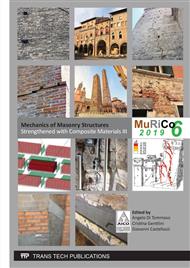[1]
M. Collepardi, Degradation and restoration of masonry walls of historical buildings, Mater. Struct. 23(2) (1990) 81-102.
DOI: 10.1007/bf02472568
Google Scholar
[2]
F. van Rickstal, Grout injection of masonry, scientific approach and modeling, PhD Thesis, Katholieke Universiteit Leuven, (2000).
Google Scholar
[3]
J. Davidovits, Geopolymers and geopolymeric new materials, J. Therm. Anal. 35 (1989) 429-441.
Google Scholar
[4]
P. Duxson, A. Fernández-Jiménez, J.L. Provis, G.C. Lukey, A. Palomo, J.S.J. van Deventer, Geopolymer technology: the current state of the art, J. Mater. Sci. 42 (2007) 2917-2933.
DOI: 10.1007/s10853-006-0637-z
Google Scholar
[5]
D. Panias, I.P. Giannopoulou, T. Perraki, Effect of synthesis parameters on the mechanical properties of fly ash-based geopolymers, Colloids Surf., A 301 (2007) 246-254.
DOI: 10.1016/j.colsurfa.2006.12.064
Google Scholar
[6]
F. Puertas, S. Martıinez-Ramıirez, S. Alonso, T. Vazquez, Alkali-activated fly ash/slag cements: strength behaviour and hydration products, Cem. Concr. Res. 30 (10) (2000) 1625-1632.
DOI: 10.1016/s0008-8846(00)00298-2
Google Scholar
[7]
ASTM C618-05, Standard Specification for coal fly ash and raw or calcined natural pozzolan for use in concrete, West Conshohocken, PA, (2005).
DOI: 10.1520/c0618-99
Google Scholar
[8]
L.G. Baltazar, F.M.A. Henriques, M.T. Cidade, Rheological characterization of injection grouts using rotational rheometry. In Advances in Rheology Research; Nova Science Publishers, New York, USA, 2017, pp.13-42.
Google Scholar
[9]
L.G. Baltazar, F.M.A. Henriques, M.T. Cidade. Grouts with improved durability for masonry consolidation: An experimental study with non-standard specimens, Key Eng. Mater. (2017) 747 480-487.
DOI: 10.4028/www.scientific.net/kem.747.480
Google Scholar
[10]
L.G. Baltazar, F.M.A. Henriques, M.T. Cidade, Rheology of natural hydraulic lime grouts for conservation of stone masonry-influence of compositional and processing parameters, Fluids 4(1) (2019) 13.
DOI: 10.3390/fluids4010013
Google Scholar
[11]
EN 1015-11:1999. Methods of Test for Mortars for Masonry - Part 11: Determination of flexural and compressive strength of hardened mortar. CEN, European Committee for Standardization (1999).
DOI: 10.3403/01905442u
Google Scholar
[12]
EN 1936:2006. Natural stone test methods – determination of real density and apparent density, and of total and open porosity (2006).
DOI: 10.3403/30149240
Google Scholar
[13]
EN 1015-18:2002. Methods of test for mortar for masonry - Part 18: Determination of water absorption coefficient due to capillary action of hardened rendering mortar. CEN, European Committee for Standardization (2002).
DOI: 10.3403/02720093
Google Scholar
[14]
EN 12370:2001. Natural stone test methods - Determination of resistance to salt crystallisation. CEN, European Committee for Standardization (2001).
Google Scholar
[15]
L.G. Baltazar, F.M.A. Henriques, R. Douglas, M.T. Cidade, Experimental characterization of injection grouts incorporating hydrophobic silica fume J. Mater. Civ. Eng. 29 (2017) 04017167.
DOI: 10.1061/(asce)mt.1943-5533.0002021
Google Scholar
[16]
M. Palacios, M.M. Alonso, C. Varga, F. Puertas, Influence of the alkaline solution and temperature on the rheology and reactivity of alkali-activated fly ash pastes, Cem. Concr. Compos. 95 (2018) 277-284.
DOI: 10.1016/j.cemconcomp.2018.08.010
Google Scholar
[17]
F. Jorne, F.M.A. Henriques, L.G. Baltazar, Influence of superplasticizer, temperature, resting time and injection pressure on hydraulic lime grout injectability. Correlation analysis between fresh grout parameters and grout injectability. J. Build. Eng. 4 (2015) 140-151.
DOI: 10.1016/j.jobe.2015.08.007
Google Scholar
[18]
F. Jorne, F.M.A. Henriques, L.G. Baltazar, Injection capacity of hydraulic lime grouts in different porous media. Mater. Struct. 48 (2015) 2211-2233.
DOI: 10.1617/s11527-014-0304-9
Google Scholar
[19]
C.K. Yip, G.C. Lukey, J.L. Provis, J.S.J. van Deventer, Effect of calcium silicate sources on geopolymerisation, Cem. Concr. Res. 38 (2008) 554-564.
DOI: 10.1016/j.cemconres.2007.11.001
Google Scholar
[20]
J. Temuujin, A. van Riessen, R. Williams, Influence of calcium compounds on the mechanical properties of fly ash geopolymer pastes, , J. Hazard. Mater. 167 (2009) 82-88.
DOI: 10.1016/j.jhazmat.2008.12.121
Google Scholar
[21]
J. Temuujin, A. van Riessen, Effect of fly ash preliminary calcination on the properties of geopolymer, J. Hazard. Mater. 164 (2009) 634-639.
DOI: 10.1016/j.jhazmat.2008.08.065
Google Scholar
[22]
H.M. Khater, Effect of calcium on geopolymerization of aluminosilicate wastes, Mater. Civ. Eng. 24 (2012) 92-101.
DOI: 10.1061/(asce)mt.1943-5533.0000352
Google Scholar


